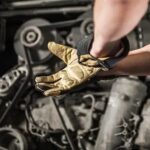Rust is a car owner’s nightmare. Left unchecked, this corrosive process can significantly degrade your vehicle, turning metal into flaky debris and diminishing its value and lifespan. While modern vehicles are manufactured with rust protection, daily use and environmental factors can compromise these defenses, leading to the dreaded appearance of rust spots. The good news is, you don’t always need to resort to expensive body shop repairs. For surface rust, tackling the problem yourself is entirely achievable, saving you a considerable amount of money and prolonging the life of your car. This guide will walk you through the process of how to repair rust spots on your auto, providing you with the knowledge and steps to confidently restore your car’s bodywork.
Why Repair Rust Spots Yourself? The Benefits of DIY Auto Rust Repair
Considering professional rust repair can be daunting, primarily due to the potential cost. Body shop repairs for rust, especially if multiple panels are affected, can quickly escalate into hundreds, if not thousands, of dollars. By taking the DIY approach to rust spot repair, you can drastically reduce these costs, investing instead in the necessary tools and materials which are significantly less expensive than labor charges. Think of it as an investment in your car and your skillset. Beyond the financial savings, there’s a sense of accomplishment and satisfaction in restoring your vehicle yourself. Knowing you’ve proactively addressed a problem and extended the life of your car offers peace of mind and a deeper connection to your vehicle’s upkeep.
Understanding the Scope: Surface Rust vs. Structural Damage
Before you embark on your DIY rust repair journey, it’s crucial to understand the type of rust damage you’re dealing with. This guide focuses on surface rust, which is corrosion that affects the outer panels of your car and hasn’t yet eaten through the metal or compromised the vehicle’s structural integrity. We are not addressing severe structural rust, such as rotted floorboards, holes in the bodywork, or damage to sills or chassis rails. These types of extensive rust damage require professional intervention, often involving welding and more complex repairs.
Surface rust typically appears as small spots or patches, often bubbling up under the paint. If you catch it early, before it penetrates deep into the metal, DIY repair is highly effective. However, if you’re unsure about the extent of the rust or suspect structural damage, always consult with a professional mechanic or body shop for a proper assessment. Attempting to DIY repair structural rust can be unsafe and may lead to further complications.
Essential Tools and Materials for Rust Spot Repair
To effectively repair rust spots on your car, you’ll need to gather the right tools and materials. Having everything prepared beforehand will streamline the repair process and ensure a smoother, more professional-looking finish. Here’s a comprehensive list of what you’ll need:
- Angle Grinder with Flapper Wheels: This is essential for removing surface rust quickly and efficiently. Flapper wheels in various grits will help you gradually smooth the area.
- Wire Brush: A wire brush, either manual or drill-powered, is useful for removing loose rust and debris in tighter spots and for initial surface cleaning.
- Fibreglass Epoxy Gel: For areas where rust has created minor holes or weakened the metal, fibreglass epoxy gel provides a strong, waterproof filler.
- Body Filler (Bondo): Body filler is used to smooth out imperfections and create a level surface after rust removal and epoxy application.
- Various Grades of Sandpaper: You’ll need a range of sandpaper grits, typically starting with coarser grits like 80 for initial shaping, moving to 400, 600, 1000, and even 2000 for progressively finer smoothing and preparing for paint.
- Sanding Block: Using a sanding block ensures even pressure and a flat sanding surface, preventing unevenness and swirl marks.
- Primer: Primer is crucial for creating a base layer that promotes paint adhesion and provides corrosion protection.
- Base Coat Car Paint (Color-Matched): Obtain car paint that precisely matches your vehicle’s color code for a seamless repair. Aerosol cans are convenient for smaller repairs.
- 2K Clear Coat Paint (Aerosol Can): Clear coat adds a protective, glossy top layer, enhancing the paint’s durability and shine. 2K clear coat offers better resistance to scratches and UV damage.
- Masking Materials: Use masking paper and tape to protect surrounding areas from overspray during priming and painting.
- Rubbing Compound: Rubbing compound is used after clear coat application to buff out minor imperfections and achieve a smooth, polished finish.
- Mineral Spirits or Wax and Grease Remover: These are essential for cleaning the repair area before each step, ensuring proper adhesion of materials.
- Rags and Tack Cloth: Clean rags are needed for applying cleaners and rubbing compound. Tack cloth is used to remove dust and debris just before painting, ensuring a clean surface.
Step-by-Step Guide: How to Repair Rust Spots on Your Car
Now that you have your tools and materials ready, let’s walk through the process of repairing rust spots on your car, step-by-step:
Step 1: Preparation and Cleaning
Begin by thoroughly cleaning the area around the rust spot. Wash the area with soap and water to remove dirt and grime. Once dry, use mineral spirits or a wax and grease remover to eliminate any wax, grease, or silicone that could interfere with adhesion. Mask off the surrounding area with masking paper and tape, leaving only the rust spot and a small margin around it exposed. This protects the surrounding paint from accidental damage during the rust removal process.
Step 2: Rust Removal
This is the most crucial step. Equip your angle grinder with a flapper wheel (start with a coarser grit like 80). Carefully grind away the rust, working from the outside edges of the rust spot inwards. Apply moderate pressure and keep the grinder moving to avoid overheating the metal or grinding too deeply. The goal is to remove all visible rust and expose clean, bare metal. For hard-to-reach areas or smaller rust spots, a wire brush can be effective in removing surface rust. Ensure you remove all traces of rust; any remaining rust will continue to corrode under your repair.
Step 3: Applying Fiberglass Epoxy (If Necessary)
If the rust has eaten through the metal, leaving small holes or weakened areas, you’ll need to use fibreglass epoxy gel. Clean the area again with mineral spirits. Mix the fibreglass epoxy according to the manufacturer’s instructions. Apply the epoxy to the damaged area, ensuring it fills any holes and slightly overlaps the surrounding metal. Let the epoxy cure completely as per the instructions. Once cured, sand the epoxy smooth using progressively finer grits of sandpaper (start with 80 and move to 400) on a sanding block until it is level with the surrounding panel.
Step 4: Body Filler Application
Apply a thin layer of body filler over the repaired area, feathering the edges onto the surrounding paint. The purpose of body filler is to smooth out any imperfections and create a seamless transition between the repaired area and the original panel. Mix the body filler with hardener according to the product instructions. Apply in thin coats, allowing each coat to harden before applying the next. Avoid applying too much filler at once, as it’s easier to add more than to remove excess. Once the filler is fully hardened, begin sanding with 80-grit sandpaper on a sanding block to shape it and remove the bulk of the excess. Gradually move to finer grits (180, then 400) to refine the shape and smooth the surface.
Step 5: Sanding and Priming
After shaping the body filler, continue sanding with progressively finer grits of sandpaper (600 and then 800 or 1000) to create a very smooth surface ready for primer. Clean the repair area thoroughly with a tack cloth to remove all sanding dust. Apply several thin coats of primer, allowing each coat to dry completely before applying the next. Primer helps to fill any remaining minor imperfections and provides a uniform surface for the paint to adhere to. Once the primer is dry, lightly wet sand it with 1000 or 1200-grit sandpaper to ensure a perfectly smooth surface. Clean again with a tack cloth.
Step 6: Painting
Apply the base coat car paint in thin, even coats, holding the aerosol can about 8-10 inches from the surface. Overlap each pass slightly. Apply several coats for good coverage, allowing each coat to flash dry (become slightly tacky) before applying the next. Refer to the paint manufacturer’s instructions for drying times and recommended number of coats.
Step 7: Clear Coat and Finishing
Once the base coat is completely dry, apply 2-3 coats of 2K clear coat in the same manner as the base coat, allowing flash dry time between coats. Clear coat protects the base coat and provides a glossy finish. Allow the clear coat to dry completely, typically for at least 24-48 hours depending on temperature and humidity. After the clear coat is fully cured, use rubbing compound and a clean rag to buff out any minor imperfections or orange peel texture in the clear coat. This will enhance the shine and blend the repaired area seamlessly with the surrounding paint. Finally, remove the masking and clean the area.
Conclusion: Taking Control of Car Rust Repair
Repairing rust spots on your car yourself is a rewarding and cost-effective way to maintain your vehicle’s condition and appearance. By following these steps and taking your time, you can effectively eliminate surface rust and protect your car from further corrosion. While this guide focuses on DIY repair, remember to assess the extent of the rust damage accurately. For severe or structural rust, professional repair is always the safest and most reliable option. Regular car washing and prompt attention to paint chips and scratches can prevent rust from forming in the first place, saving you time and effort in the long run.


